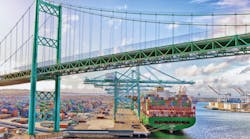Harmful algal blooms: A guide to combatting rising challenges
Harmful algal blooms (HABs) are increasingly becoming a concern as climate change continues to cause extreme weather conditions year after year. HABs grow in calm water due to warmer temperatures and are becoming more prevalent worldwide. In fact, a recent study tracking algal blooms globally from 2003 to 2020 found that they increased in frequency by over 59%. Stormwater runoff from urban areas, farms and residential communities can introduce excess nutrients such as nitrogen and phosphorus into waterways. These nutrients, which are the main causes of HABs, come from fertilizers, sewage and other sources.
The growing frequency and severity of HABs pose multiple challenges to stormwater and wetland professionals. Some of the negative effects that must be mitigated include damaged water systems and harm to local wildlife. To protect public and ecological health, the industry must start preparing now for the 2025 bloom season, which usually peaks in the summer and early fall. Through understanding the threat of HABs, learning proactive steps to mitigate the effects of them and response planning, professionals can be more prepared.
The threat of HABs
HABs are a cause for concern due to the toxins they produce. One specific toxin called mycrocystin is created by blue-green algae HABs. This toxin is not only harmful to humans and animals but is also challenging for stormwater management and wetland preservation professionals to manage due to its ability to overwhelm traditional water treatment systems. Professionals may need to utilize innovative solutions for water treatment and discharge to address toxins.
While we have seen HABs impact large bodies of water in recent years, smaller water areas should not be ignored. HABs can have a significant, negative impact on wetlands and other water sources they feed into. They can also damage stormwater infrastructure and drain systems, increasing the amount of nutrients in runoff. The threat of HABs to our systems requires timely solutions to avoid this damage and the need for more frequent and costly maintenance.
Proactive measures for the HAB season
Some of the proactive measures require both investment and time. Therefore, preparation for the summer and early fall seasons should begin now to ensure systems are ready. Proactive steps water professionals can take include:
Utilizing predictive modeling
While HABs may be more severe now, they are not new. Harness historical data and predictive models to help identify where and when bloom hotspots may occur. Having a robust monitoring program in place is essential for the early detection of algal growth and timely intervention.
Using advanced monitoring and treatment technologies
Early detection of algal blooms is essential in treating them quickly before they cause major damage. Consider investing in remote-sensing technology and in-situ testing to identify current bloom conditions. Additionally, progressive technology may be needed as HABs become more frequent, such as advanced oxidation processes for toxin removal and chemical and biological treatments to help break down harmful toxins developed from algal.
Optimizing stormwater management practices
Sustainable infrastructure solutions that utilize natural filtration methods to reduce nutrient loads can help with stormwater management during HABs. For example, in wetlands, bioretention areas can help naturally process nutrients, reducing the risk to the large water bodies they fill into. Additionally, aeration systems for retention basins can make it harder for algae to grow.
Partnering with industry groups
Networking with other water professionals can hasten the adoption of innovative water treatment technologies and best practices in the industry. It can also contribute to more research data from the regions experiencing HABs. Coordinate with local watershed groups to share learnings and partner on monitoring and response efforts. Leverage collaborations with academic institutions who are researching HAB prevention and mitigation.
Engaging with the community
Local community members can play an unexpected role in helping professionals detect HABs through monitoring and reporting bloom activity. Furthermore, they can reduce their contribution to helping HABs grow. Work to educate residents and local agricultural sectors on the causes of HABs and how to reduce nutrient runoff from their properties.
HAB response planning
Stormwater and wetland professionals must consider different HAB risks and scenarios as they bolster their plans for the 2025 season. A great first step in the response planning process is to evaluate the current infrastructure and pinpoint HAB vulnerabilities. Upgrades to filtration systems, water flow dynamics and technology may be needed to help manage algal growth and protect nearby communities.
For many, there may be HAB vulnerabilities in the system. This underscores the importance of having a comprehensive response plan that includes how HABs evolve. Be sure to include specific actions for various scenarios, the stakeholders needed for those actions and details on their roles and responsibilities during bloom detection. The plan should also include staff training to ensure all team members are informed on how to identify, treat and manage an HAB.
If there is ever compromised water quality during times of HAB growth, water professionals can educate the public on point-of-use solutions that can help provide an additional layer of protection in drinking water. Water filters certified to NSF/ANSI 53 for microcystin reduction provide an extra tool in protecting communities against the impacts of HABs. In selecting a verified filtration system, begin by identifying NSF/ANSI 53 certified choices as part of a multi-barrier approach.
Remaining agile to adapt to climate change
Climate change continues to present more challenges to stormwater and wetland professionals as the focus on mitigating its negative impacts on our water systems and environment grows. Until we mitigate the climate crisis, the threat of HABs is not going away, requiring our approach to stormwater and wetland management to evolve.
Advanced preparations will help to ensure that water professionals and systems are ready for the 2025 bloom season. Adaptation, innovation and collaboration are all crucial components of building stronger water systems and practices that can handle the threat of HABs. It will take a collaborative effort, requiring us to partner and share industry knowledge to help us quickly adapt to rising threats together. Through historical data and new technologies, we can better prepare our water systems and teams for challenges, helping safeguard public health and the natural environment for years to come.
About the Author
Kyle Postmus
Kyle Postmus is senior manager at NSF.



